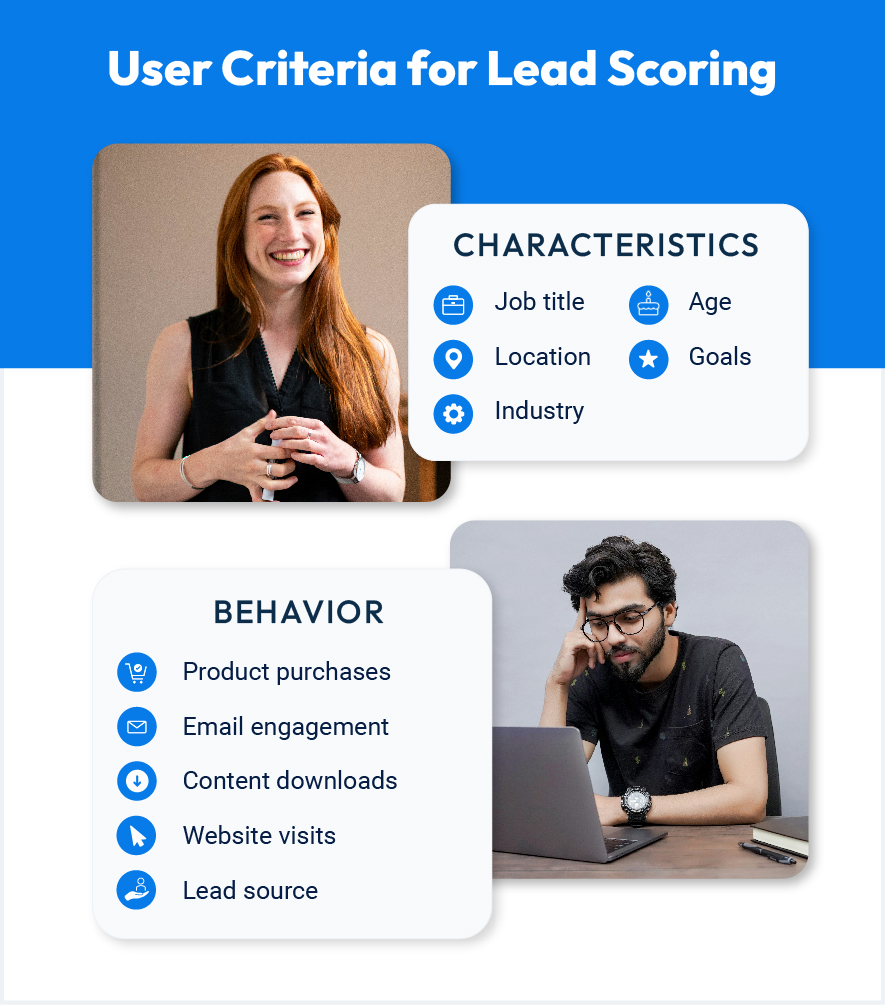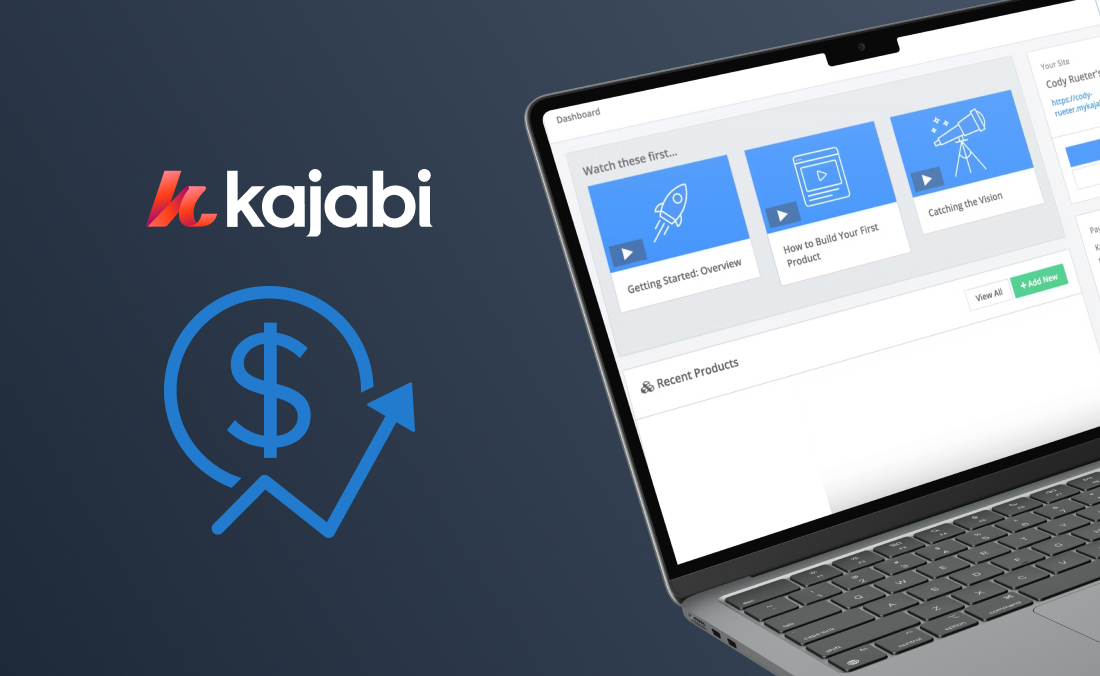The leads in your system don’t carry equal potential for a sale. Some leads line up with your ideal customer profile more than others or are more actively engaged with your brand. Lead scoring is an important process that categorizes these sales leads so you can manage your resources effectively and personalize buyer journeys. Read on for details about how lead scoring works and how to use it effectively in your business!
What is Lead Scoring?
Lead scoring is a way to measure lead quality — assigning a numerical value to a lead based on user characteristics and/or user behavior. A higher score indicates that a lead is a strong fit for your product or highly engaged with your brand, or both. A lower score indicates that someone is less likely to buy because they’re not the right fit or not interested in buying, or both.
While it’s possible to manually track and sort leads, automation has taken lead scoring to the next level. Website forms capture lead information, lead scoring software assigns point values based on your rules, and automated workflows integrate with your lead management software to nurture leads on autopilot.
Lead Scoring Criteria
The specific factors that indicate someone is a “good lead” will depend on your business and target audience. But two main types of criteria you’ll want to consider are user characteristics and user behavior.
User Characteristics
User characteristics include factors such as a lead’s job title, industry, location, age, or personal goals. Demographic data is a big part of this category of scoring factors. The lead capture form gathers these straightforward details that tell you something about who the prospect is and whether they’re a good fit for your products or services.
For example, a career coach could use lead scoring to prioritize leads with particular job titles, finding that people in certain roles tend to be the most eager learners. The coach’s inquiry form would need a field where the lead specifies their role, alongside any other relevant details — such as their industry.
Want to create more effective opt-in forms? Check out our guide: How to Build a Lead Capture Form
User Behavior
Behavioral data includes a more complex set of lead-scoring criteria that tell you something about a lead’s level of interest in your brand and intent to buy. These factors include email open rates and click-through rates, content downloads, website visits, and any other type of action someone takes on your website or through other marketing channels.
For example, someone who signed up for a free trial on your pricing page is almost certainly a better lead than someone who signed up for a newsletter. And someone who attended an hour-long webinar is probably a better prospect than someone who downloaded a whitepaper. Certain actions indicate stronger intent than others — but you’ll have to track the conversion data to find out what those actions are!

Negative Scoring
Assigning negative points to leads is a convenient way to automatically remove leads from lead nurturing sequences or ensure they don’t end up on a high-priority list. Leads can be disqualified based on behavior patterns such as unsubscribing from emails or user characteristics like their location or job title.
How Do You Calculate Lead Scoring?
Lead scoring models vary from business to business — it’s important thing to set the rules and goals for your scoring model ahead of time so your methodology is consistent.
One of the simplest ways to calculate lead scores is to set a maximum score of 100 and divide up the points between each of the factors that contribute to the score. If you decide to score leads based on both user characteristics and user behavior signals, you could set a maximum of 50 points per category to account for both types of criteria.
If you’re wondering where to get started, analyze current conversion rates to determine the relative importance of each factor based on what you observe. You can also test factors that you have reason to believe are important from your own experience. And it’s a good idea to talk to or survey your customer base to understand more about your ideal customer and their buyer journey. There might be key behavior signals or shared characteristics of great leads that don’t show up in analytics reports.
Your scoring model will begin with educated guesses, and you will adapt your strategy over time. The first lead scoring model you try will inevitably need to be adjusted as you test different scoring factors, analyze ongoing conversion data, and learn more about your audience.
Predictive Lead Scoring
Predictive lead scoring leverages machine learning to streamline the lead scoring process even further. Predictive scoring software uses advanced algorithms to adapt your lead scoring model for the future — ”predicting” who the best leads will be based on past data points.
How to Use Lead Scoring Effectively
The most impactful uses of your lead scoring system will depend on your company size and structure, but there are some universal advantages to prioritizing your leads by their sale potential. Here are a few ideas on how to get the most value out of lead scoring:
Prioritize High-Quality Leads
Perhaps the most practical use for lead scoring is streamlining internal sales processes. This is particularly true for a business with a marketing and sales teams trying to work in alignment. Lead scoring helps make sure the sales reps focus on qualified leads who are worth their time.
Using your time effectively is essential no matter whether you have a dedicated sales team or run your own online business – and lead scoring is a key tool for resource allocation. This doesn’t mean you or your sales reps should only follow up with the potential customers most likely to convert. That’s up to you. However, lead scoring does help ensure that high-value leads are less likely to fall through the cracks.
Customize Lead Nurturing Sequences
Lead scoring isn’t just a practical necessity for pipeline management, it also opens many opportunities for personalized lead nurturing that boosts conversion rates. When you integrate lead scoring with sales funnel software, you can set up automated workflows that are triggered when a lead reaches a certain threshold.
For example, your most engaged leads could be sent down a marketing path where they receive conversion-focused content such as discounts, upsells, and cross-sell offers. Meanwhile, less invested leads would continue to receive primarily educational content that builds trust over time.
How do you integrate lead scoring with email automation?
Native API functionality or third-party tools like Zapier enable you to connect separate lead management and marketing software applications. Alternatively, you can unite your sales and marketing efforts with an all in one platform like Kartra. Kartra provides lead management and email marketing functionalities that work together, no integration required.
Use Scoring Insights to Improve Your Marketing Strategy
A lead scoring system will provide you with valuable insights about your customer base, your brand, and your marketing efforts. For example, if your highest-scoring leads consistently come from the same lead source, this tells you a lot about which lead generation tactics are working best. Or, you may identify common characteristics among people who resonate with your brand‚ — such as their job title or goals. Consider how you can put these insights to use as you update your ideal customer profile and optimize marketing campaigns at a higher level.
Lead Scoring Tools
For lead scoring to be a natural part of your business operations and not another manual task, you’ll need certain software applications. These tools save time and effort by automating lead management and marketing processes:
Comprehensive Data Analytics
Sales and marketing analytics are the foundation of any lead scoring system. Scoring is a data-driven method for sorting leads, requiring an accurate picture of the customer journey. You need to know who is interacting with your business (user characteristics), how they engage with your brand (user behavior), and how those factors relate to sales (conversion data).
If your business takes advantage of multiple marketing channels, you likely have a variety of analytics dashboards — covering website interactions, email engagement, and other key metrics. One of the best ways to integrate all this data is by using an all in one platform for marketing and lead management, such as Kartra.
Lead Management System
A lead management platform is the primary tool you’ll need to implement lead scoring. A quality lead management system will organize and segment your new leads, allow you to assign rules for lead scoring and tagging, and track your leads’ journey through the sales cycle.
This software should integrate with your email marketing platform, sales funnel builder, and any other tools you use to engage leads and customers. Or, choose an all in one platform like Kartra for native lead management tools and marketing automation tools that are designed to work together seamlessly.
Find the right software for your business in our guide to the top lead management and CRM platforms
Lead Capture Form Builder
A form builder is necessary for capturing lead information in the first place. From contact forms to email sign-up forms, opt-in forms are important touch points along the customer journey. A quality form-builder will feature professional templates, drag-and-drop functionality, and the ability to customize form fields to the level of detail that you need. It should also integrate seamlessly with your lead management platform so contact details stay accurate and organized.
Sales Funnel Integration
When choosing a lead scoring tool, it’s important to look beyond its immediate functionalities for sorting leads. How do you intend to use the details you’re gathering about those leads? If you want to set up automated sequences and customize buyer journeys according to lead scores, your lead management system will need to integrate well with your sales funnel builder.
For seamless integration, choose an all in one lead management and marketing platform like Kartra. Kartra’s full slate of native features — including a lead management system, form builder, and sales funnel builder — align marketing and sales activities so you can stay organized and optimize buyer journeys for higher conversion rates.


